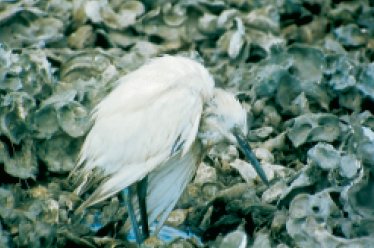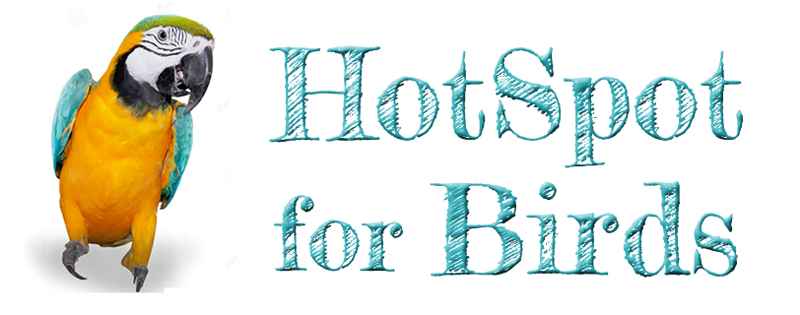by Hannis L. Stoddard, III, DVM
When a doctor of veterinary medicine tells a client his bird has psittacosis, the reaction can range from hysteria to joy. Why does the word psittacosis create such diverse and unpredictable human response?
The reason, of course, is that the disease historically has been misunderstood and misrepresented, exaggerated and underestimated, by regulatory agencies, veterinarians, bird owners, and the general public. It has also caused economic hardship, human illness and heartache.
The word psittacosis is derived from the Greek work Psittakos, which means parrot. It is a label for a disease in birds that has been recognized for the last century. Called psittacosis if it infects psittacines (parrots, parakeets, cockatoos, etc.), the same malady is termed ornithosis if it infects other types of birds. Other names include parrot fever and chlamydiosis.

An immature blue heron with psittacosis
The causative agent is Chlamydia psittaci. This "microvarmit" is like a bacteria (in that it responds to antibiotics) as well as like a virus (in that it will grow only on a tissue culture, not on bacterial media).
C. psittaci's ability to mystify us does not end with classification. It can cause disease in humans, other mammals and birds. It can kill a bird in 48 hours or it can survive in birds causing no outward sign of illness, for as long as 10 years. It can be explosively contagious or barely contagious. It can be destroyed by antibiotics easily or with incredible difficulty. It can be easy to diagnose or extremely frustrating. It can kill baby birds and cause no disease in their parents. It can live outside the body, as well as within. It can be easy to control or almost impossible. It causes massive flock outbreaks one year and none the next.
Individual Susceptibility
The incubation period of psittacosis, as well as the degree of clinical illness, adds to our bewilderment. Just how a bird manifests its exposure to the disease depends on host susceptibility and the virulence (strength) of the strain.
Host susceptibility. Some birds, because of their genetic resistance, are less likely to become ill and, consequently, are more likely to develop into carriers. These include pigeons (one study suggests 70 to 90 percent of all wild pigeons are carriers), doves, budgerigars, cockatiels, cockatoos, herons, gulls, hawks, and approximately 100 additional sylvatic species. Other species, such as rosellas, lorikeets, neophemas, mynahs, canaries and some parrots have low natural resistance and are highly susceptible.
Young birds, due to the relatively incompetent immune systems, are subject to neonatal psittacosis with subsequent high mortality. Any factor that stresses a bird will lower its resistance and increase its potential susceptibility and mortality. Egg production, feeding young, weaning, poor management, overcrowding, concurrent infections and molting are just a few of the many things that stress birds.
The individual power of any agent to infect is known as virulence. This power is subject to change, especially as it inoculates birds and is passed out in the stool. Since each gram of stool from diseased birds can infect 10,000 other birds, the agent's power to cause psittacosis becomes very pertinent.
Transmission
Transmission of C. psittaci is also unsettling. The organism is shed in the nasal secretions and in the stool from infected birds, recovering birds and carriers. Once outside the body, the organism can live for a long period of time, drying to form dust and infecting the susceptible hosts as they breathe. Fecal and oral contamination are especially significant in crowded conditions, as well as in nest boxes. As a general rule, inhaled Chlamydia will cause severe disease, while ingested Chlamydia will tend to develop into carriers.
Transmission through the egg has been experimentally produced in ducks, but as a practical problem, is not documented in psittacines.
Symptoms and Diagnosis
The clinical symptoms can be variable, depending on the species infected, the virulence of the agent, the route of exposure and concurrent stresses. The "typical psittacotic bird" is ruffled, depressed, has labored breathing, nasal and ocular discharge, and is neither eating nor vocalizing. The appearance of lime-green or yellow droppings, especially when the urine component is discolored, is highly suggestive, although not diagnostic, of the malady.
One form of psittacosis seen infrequently manifests central nervous system signs. Tremors, shaking, head twisting and convulsions may be the only symptoms you see. This clinical peculiarity has been recognized in Amazons, African greys and cockatoos. Cockatiels can develop a psittacosis syndrome that causes paralysis of the limbs, and usually dark, tarry stools. Additionally, cockatiels and neophemas (turquoisines, scarlet-chested parakeets) with low-grade infections may seem to have an eye disease resembling a sty.
Diagnosis of chlamydiosis in birds is definitive only if the organism is identified, isolated or causes a predictable physiologic response. The identification of the organism is achieved by stains or a fluorescent antibody test.
Treatment
Treatment for parrot fever is now much more successful than it once was. Most veterinarians use tetracycline and its derivatives, mainly Vibramycin, to treat sick patients as well as carriers. The antibiotic can be given by intravenous or intramuscular injections, orally or mixed in proper ratios with palatable food. Calcium must be withheld - it binds the tetracycline. Blood levels of tetracycline can be enhanced by citric acid in the birds' drinking water.
Patients in chlamydial crisis need intense, supportive care (heat, isolation, extremely clean conditions, absence from stress, etc.) as well as therapy for concurrent problems. Appropriate lactobacillus, as well as antifungal medications, are essential.
Control and Prevention
Controlling avian psittacosis is best accomplished by keeping susceptible birds away from the infecting agent. Since this little "microvarmit" can remain infective for many months in dried excrement, cleanliness and disinfection are essential. The Chlamydia species is inactivated by quaternary ammonium compounds. These disinfectants should be used to clean cages and wet-mopped on surrounding areas. Eliminating drafts and spraying the area with disinfectants will help keep infectious feathers and dust to a minimum. Birds that have had the disease or are under treatment are fully susceptible to reinfection since the disease does not convey immunity.
In wild birds, psittacosis is controlled naturally by the inability of sick birds to keep up with the flock. Additionally, infective droppings fall to the ground below the trees in which the birds perch. The clinical disease that we see in pets is promoted by confining, crowding, transporting, dietary changes, exposure to other infections and forced exposure to infective excrement.
Regulations
Any disease, such as chlamydiosis, that can infect humans and other mammals involves both public health officials and animal health regulation agencies. Different states, as well as the counties within them, have different laws that are enforced so arbitrarily that they become discriminatory. The purpose of she regulations is to stop the spread of disease from animals to man and to animals that are used for human food (such as from parrots to turkeys). While many of these regulations have been successful, psittacosis control has not been.
The format for the regulatory agencies' involvement is confusing and changing, but goes something like this: Psittacosis is a reportable disease to the U S. Department of Agriculture and/or the Public Health Department.
The U.S. Department of Agriculture is charged with animal health. Chlamydiosis can cause infectious abortions in sheep, cattle and goats. The disease can also infect dogs, cats and horses, but these animals do not seem able to spread the illness; they are end-stage hosts.
The Public Health Department is charged with controlling human illnesses. Since the disease can be spread from birds to humans, public health officials are involved. When I checked with the Center for Disease Control in Atlanta, they said, "Psittacosis is an under-reported human disease. There were two human deaths, both elderly (1978 and 1983), that listed psittacosis as contributory but not primary. Over the last decade there have been approximately 150 cases per year of human psittacosis, 70 percent of which could be traced to exotic birds and 20 percent to turkey farms and poultry dressing plants."
Reports on the incidence of psittacosis in humans are conflicting, however. Another report suggests a tenfold increase in human disease. The incidence of psittacosis in birds is also undetermined. One report shows a fivefold increase (to 19 percent of all birds tested), while the California State Lab says only about four percent are infected.
One or both of the regulatory agencies decides which diagnostic test, as well as which treatment regimen, is "approved. " The problem is that if the veterinarian uses a "non-approved" diagnostic test, the patient does not officially have psittacosis even if the test is positive. Recent advantages in serological (blood) testing have given the veterinarian a powerful diagnostic weapon to diagnose this malady, but the test's approval is still pending.
The problem escalates. If the patient has an "approved" case of psittacosis, only an "approved" therapy can be used. In 1978, I started using Vibramycin to treat psittacotic birds and experienced phenomenal results. Equally phenomenal were my legal expenses to hold onto my license, because Vibramycin was not "approved." It is now the drug of choice to treat avian psittacosis and, hopefully, soon will be "approved."
Once an "approved" positive case of psittacosis is reported, the response by the regulatory agencies is inconsistent. The action will vary from no action to a full-blown (45-day plus) quarantine with testing, treatment and more testing. The individual who sells birds for his livelihood could be ruined economically or may not even be interviewed by the officials.
Erratic government intervention has threatened pet stores, bird owners and aviculturists. Miraculous response to modern therapy has at times given false optimism to people who have previously had psittacosis in their birds.
One of my clients presented to me a relatively stable psittacotic bird about five years ago. When I diagnosed psittacosis, the client collapsed in the exam room. After that, I started telling my clients their birds had chlamydiosis and eased cautiously into what that meant.
The same client presented a bird to me six months ago. The bird was moribund, with the last flicker of life leaving its eyes when I walked into the exam room. My initial tentative diagnosis was psittacosis. Upon hearing this, the client smiled and hugged me, saying, "Great! Fix him up, Doc." This is a classic example of a client's hysteria turning into joy.
My advice to clients whose birds have psittacosis is to have reserved pessimism at first and, after therapeutic response. reserved optimism.
|
Please Give Us a Link
If you found our site to be useful, please link our website to yours. We really appreciate any help we can get in making our avian health and safety articles readily available. |
Contact Information

|
||||||||||
|
